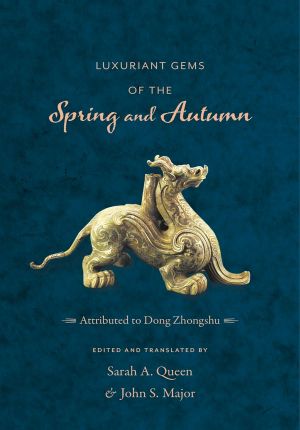Luxuriant Gems of the Spring and Autumn

- Authors
- Dong, Zhongshu & Major, John S. & Queen, Sarah A.
- Publisher
- Columbia University Press
- Tags
- history , asia , china , lco004010 , literary collections , asian , chinese , philosophy , classics , his008000
- ISBN
- 9780231539616
- Date
- 2015-12-15T00:00:00+00:00
- Size
- 17.38 MB
- Lang
- en
A major resource expanding the study of early Chinese philosophy, religion, literature, and politics, the first complete English-language translation of the Luxuriant Gems of the Spring and Autumn (Chunqiu fanlu), one of the key texts of early Confucianism
A major resource expanding the study of early Chinese philosophy, religion, literature, and politics, this book features the first complete English-language translation of the Luxuriant Gems of the “Spring and Autumn” (Chunqiu fanlu), one of the key texts of early Confucianism. The work is often ascribed to the Han scholar and court official Dong Zhongshu, but, as this study reveals, the text is in fact a compendium of writings by a variety of authors working within an interpretive tradition that spanned several generations, depicting a utopian vision of a flourishing humanity that they believed to be Confucius’s legacy to the world. The Spring and Autumn (Chunqiu) is a chronicle kept by the dukes of the state of Lu from 722 to 481 B.C.E. The Luxuriant Gems follows the interpretations of the Gongyang Commentary, whose transmitters belonged to a tradition that sought to explicate the special language of the Spring and Autumn. The Gongyang masters believed that the Spring and Autumn had been written by Confucius himself, employing subtle and esoteric phrasing to indicate approval or disapproval of important events and personages. The Luxuriant Gems augments Confucian ethical and philosophical teachings with chapters on cosmology, statecraft, and other topics drawn from contemporary non-Confucian traditions, reflecting the brilliance of intellectual life in the Han dynasty during the formative decades of the Chinese imperial state. To elucidate the text, Sarah A. Queen and John S. Major divide their translation into eight thematic sections with extensive introductions that address dating, authorship, authenticity, and the relationship between the original text and the evolving Gongyang approach.
The Spring and Autumn ( Chunqiu ) is a chronicle kept by the dukes of the state of Lu from 722 to 481 B.C.E. Luxuriant Gems of the Spring and Autumn ( Chunqiu fanlu ) follows the interpretations of the Gongyang Commentary , whose transmitters sought to explicate the special language of the Spring and Autumn. The work is often ascribed to the Han scholar and court official Dong Zhongshu, but, as this study reveals, the text is in fact a compendium of writings by a variety of authors spanning several generations. It depicts a utopian vision of a flourishing humanity that they believed to be Confucius's legacy to the world.
The Gongyang masters thought that Confucius had written the Spring and Autumn , employing subtle phrasing to indicate approval or disapproval of important events and personages. Luxuriant Gems therefore augments Confucian ethical and philosophical teachings with chapters on cosmology, statecraft, and other topics drawn from contemporary non-Confucian traditions. A major resource, this book features the first complete English-language translation of Luxuriant Gems , divided into eight thematic sections with introductions that address dating, authorship, authenticity, and the relationship between the Spring and Autumn and the Gongyang approach. Critically illuminating early Chinese philosophy, religion, literature, and politics, this book conveys the brilliance of intellectual life in the Han dynasty during the formative decades of the Chinese imperial state.--Robin D. S. Yates, McGill University